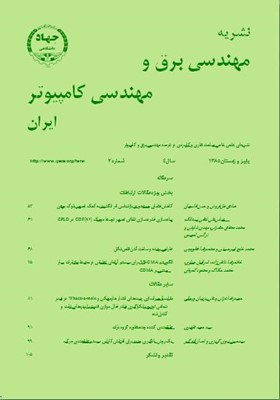مدلسازي انتشار امواج راديويي از درون ساختارهای پنجرهای با استفاده از روش معادله سهموي
محورهای موضوعی : مهندسی برق و کامپیوتر
1 - دانشگاه علم و صنعت ايران
2 - دانشگاه علم و صنعت ایران
کلید واژه: انتشار امواج راديويي در محيطهاي داخل ساختمانروش معادلات سهموي,
چکیده مقاله :
در اين مقاله، روش معادله سهموي براي حل مسأله انتشار امواج از درون ساختارهای پنجرهای مورد استفاده قرار ميگيرد. با استفاده از اين روش مسأله انتشار امواج از داخل يك مجموعه پنجره براي حالتهاي مختلف حل میشود و چگونگی تأثیر ابعاد پنجرهها بر پرتو پراش حاصل بررسی میگردد. نتايج حاصل از اعمال روش معادله سهموي براي مسأله ذکرشده در حالتهای تابش عمودی و مایل امواج صفحهای یکنواخت و نایکنواخت ارائه شده و با نتایج حاصل از روش FDTD موجود در مراجع در حالت تابش موج صفحهای یکنواخت مقایسه میشود. با توجه به تشابه زیاد نتایج حاصل از این دو روش، از آنجا که روش معادلات سهموي نسبت به روش FDTD به زمان محاسبات و حافظه كامپيوتر كمتري نياز دارد، ميتواند شيوه مناسبي براي حل چنين مسائلي باشد.
In this paper, the parabolic equation method is applied to analyze radio wave propagation through window structures. By this method, a typical window propagation situation is simulated for different window sizes and frame types. The simulation results are represented for both normal and oblique incident cases of uniform and non-uniform plane wave. Results from the implementation of the parabolic equation method show good agreement with FDTD reported simulations. Base on this study, as the parabolic equation method needs less memory size and CPU time against FDTD method, it can be used as an efficient algorithm to analyze this kind of problems.
[1] S. Y. Seidel and T. S. Rappaport, "914 MHz path loss prediction models for indoor wireless communications in multifloored buildings," IEEE Trans. Antennas Propagat., vol. 40, no. 2, pp. 207-217, Feb. 1992.
[2] S. Y. Seidel and T. S. Rappaport, "Site-specific propagation prediction for wireless in-building personal communication system design," IEEE Trans. Veh. Technol., vol. 43, no. 4, pp. 879-891,Nov. 1994.
[3] C. Yang, B. Wu, and C. Ko, "A ray-tracing method for modeling indoor wave propagation and penetration," IEEE Trans. Antennas Propagat., vol. 46, no. 6, pp. 907-919, Jun. 1998.
[4] Z. Ji, B. H. Li, H. X. Wang, H. Y. Chen, and T. K. Sarkar, "Efficient ray-tracing methods for propagation prediction for indoor wireless communications," IEEE Antennas and Propagat. Magazine, vol. 43,no. 2, pp. 41-49, Apr. 2001.
[5] J. W. H. Lee and A. K. Y. Lai, "FDTD analysis of indoor radio propagation," in Proc. IEEE Antennas and Propag. Soc. Int. Symp., vol. 3, pp. 1664-1667, Atlanta, US, 1998.
[6] L. Talbi, "Simulation of indoor UHF propagation using numerical technique," in Proc. Canadian Conf. on Electrical and Computer Eng., vol. 2, pp. 1357-1362, Boston, US, 2001.
[7] M. A. Leontovich and V. A. Fock, "Solution of propagation of electromagnetic waves along the Earth’s surface by the method of parabolic equations," J. Phys. USSR, vol. 10, pp. 13-23, 1946.
[8] V. A. Fock, Electromagnetic Diffraction and Propagation Problems,Pergamon Press, 1965.
[9] C. Mattiello, "Electromagnetic field studies in urban environment with a higher-order parabolic equation," in Proc. IEEE Antennas and Propag. Conf., pp. 355-358., 1995.
[10] C. A. Zelley and C. C. Constantinou, "A three-dimensional parabolic equation applied to VHF/UHF propagation over irregular terrain," IEEE Trans. Antennas Propag., vol. 47, no. 10, pp. 1586-1596,Oct. 1999.
[11] A. A. Zaaporozhets, "Application of vector parabolic equation method to urban radiowave propagation problems," IEE Proc.- Microw. Antennas Propag., vol. 146, no. 4, pp. 253-256, Aug. 1999.
[12] R. Janaswamy, "Path loss prediction in the presence of buildings on flat terrain: a 3-D vector parabolic equation approach," IEEE Trans.Antennas Propagat., vol. 51, no. 8, pp. 1716-1728, Aug. 2003.
[13] Z. Zhang, R. K. Sorensen, Z. Yun, M. F. Iskander, and J. F. Harvey,"A ray-tracing approach for indoor/outdoor propagation through window structures," IEEE Trans. Antennas propagat., vol. 50, no. 5,pp. 742-748, May 2002.
[14] M. F. Levy, Parabolic Equation Methods for Electromagnetic Wave Propagation, London, U. K.: IEEE Press, 2000.
[15] A. Bambeger, B. Engquist, L. Halpern, and P. Joly, "Parabolic wave equation approximations in heterogeneous media," SIAM J. Appl. Math., vol. 48, no. 1, pp. 99-128, 1988.
[16] J. F. Claerbout, Fundamentals of Geophysical Data Processing with Application to Petroleum Prospect, McGraw-Hill, New York, 1976.
[17] M. D. Collins, "A split-step Padé solution for the parabolic equation method," J. Acoust. Soc. Am., vol. 93, no. 4, pp. 1736-1742, 1993.
[18] M. D. Collins, "A two-way parabolic equation for acousticbackscattering in the ocean," J. Acoust. Soc. Am., vol. 91, no. 3,pp. 1357-1358, Mar. 1992.
[19] J. P. Berenger, "A perfectly matched layer for the absorbtion of electromagnetic waves," J. Comp. Phys., vol. 114, no. 2, pp. 185- 200, 1994.
[20] J. F. Collino, "Perfectly matched absorbing layers for the paraxial equations," J. Comp. Phys., vol. 131, no. 1, pp. 164-180, Feb. 1997.
[21] A. Z. Hyaric, "Wide-angle nonlocal boundary conditions for the parabolic wave equation," IEEE Trans. Antennas Propagat., vol. 49,no. 6, pp. 916-922, Jun. 2001.
[22] N. Noori and H. Oraizi, "Analysis of Electromagnetic Wave Propagation Into Reinforced Concrete Walls Usin Parabolic Equation Method," in Proc. ISAP05, pp. 737-740, 2005.
[23] M. Dolukhanov, Propagation of Radio Waves, Moscow, Mir Publishers, 1971.

